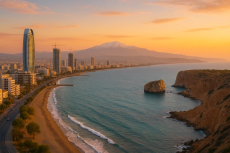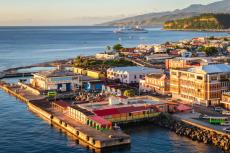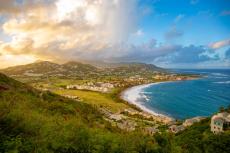Blog • Published on:April 21, 2025 | Updated on:April 18, 2025 • 13 Min
Montenegro Passport Visa-Free Countries 2025: Comprehensive Guide to Visa-Free, Visa on Arrival, and eVisa Destinations
In 2025, Montenegrin citizens enjoy visa-free or visa-on-arrival access to over 130 countries and territories, reflecting the country's expanding diplomatic relationships and its aspirations for European Union membership. This access facilitates travel for tourism, business, and cultural exchange, enhancing Montenegro's global mobility.
However, the landscape of international travel is dynamic. Recent developments, such as the European Union's request for Montenegro to align its visa policies with EU standards, have led to changes in visa-free agreements with certain countries.
For instance, Montenegro agreed to exclude countries requiring an EU visa from its visa-free list, affecting nations like Bahrain and Saudi Arabia.
This guide provides an up-to-date overview of the countries Montenegrin passport holders can visit without a visa, obtain a visa on arrival, or apply for an electronic visa (eVisa).
It also outlines important travel considerations and upcoming changes that may impact Montenegrin travelers.
Travel Access for Montenegrin Passport Holders
Understanding Montenegro's Visa-Free Travel Privileges
Montenegro's visa-free agreements are a result of years of strategic bilateral relationships and its ongoing alignment with European norms.
As of 2025, Montenegrin passport holders can travel to nearly 100 countries without a visa, mostly for short stays ranging from 30 to 90 days.
Why Does Montenegro Have So Many Visa-Free Agreements?
Montenegro’s global mobility is influenced by a few key factors:
- EU Candidate Status: Although Montenegro is not yet a member of the European Union, its candidate status has prompted cooperation with the Schengen Zone. Citizens can travel freely across much of Europe, though an ETIAS (European Travel Information and Authorization System) will be required starting late 2025.
- Reciprocal Travel Policies: Montenegro offers visa-free access to nationals of several countries, encouraging reciprocal treatment for its own citizens. This is common with nations across Latin America, Southeast Asia, and the Balkans.
- Non-Schengen Balkan Travel: Montenegrins benefit from long-standing open-border agreements with neighboring countries like Serbia, North Macedonia, Bosnia and Herzegovina, and Albania. These arrangements support tourism, trade, and personal travel without bureaucratic hurdles.
Are There Any Limitations?
Yes, despite broad access, there are several important caveats:
- Duration Limits: Visa-free status typically allows stays of 30 to 90 days. Overstaying, even by a few days, can result in fines or bans from re-entry.
- No Work Privileges: Visa-free does not mean work-free. Montenegrin travelers can’t legally take up employment unless a separate visa or permit is granted.
- Passport Validity: Most countries require a passport valid for at least 6 months from the date of entry. Some also require proof of onward travel or hotel bookings.
- ETIAS Rollout in 2025: Travel to Schengen countries will require ETIAS registration, a simple online form costing €7, for Montenegrins from late 2025. Though not a visa, it’s an added layer of travel authorization.
Montenegro Passport Ranking and Travel Freedom
Montenegro’s passport has quietly become one of the more travel-friendly documents in Southeast Europe.
While it may not rank among the top global passports, it holds considerable weight in terms of regional access and convenience, especially for travelers who frequent Europe, the Middle East, and parts of Asia.
Where Does the Montenegro Passport Rank in 2025?
According to the most recent data compiled by VisaGuide.World and corroborated by travel databases like VisaIndex and Passport Index (excluding commercial CBI sources), the Montenegrin passport offers access to approximately 130 destinations, including visa-free, visa on arrival, and eVisa options.
- Global Ranking: Generally falls between 43rd and 48th place depending on methodology
- Visa-Free + VOA + eVisa Access: 130 countries
- Visa-Free Only: 98 countries
While this is lower than EU countries like Germany or France, it’s comparable to countries like Serbia, Georgia, and even Argentina in terms of total travel access.
What Makes the Montenegrin Passport Valuable?
Here’s why global citizens and frequent travelers still see value in holding a Montenegro passport:
It’s also worth noting that Montenegro has fewer entry restrictions than neighboring Serbia or even North Macedonia, especially when it comes to access to countries in Central America, Southeast Asia, and parts of Africa.
Complete List of Visa-Free Countries for Montenegro Passport Holders
Below is a categorized, continent-by-continent list of countries where Montenegrin citizens can travel without a visa for short stays (typically 30–90 days).
What Visa-Free Access Means for Montenegrin Travelers in 2025
Visa-free travel isn’t just about avoiding paperwork. It shapes how Montenegrins move through the world, from planning a spontaneous weekend in Paris to exploring South American jungles without embassy visits or red tape.
Here’s what this freedom really means and how to use it wisely.
The Real Advantages of Visa-Free Travel
- Saves Time and Money: No visa applications, no embassy appointments, and no extra fees. For frequent travelers, this can save hundreds of euros each year.
- Increases Travel Flexibility: Planning a last-minute trip? Visa-free destinations let you book flights and go, especially within Europe or Southeast Asia.
- Builds a Travel Strategy: For digital nomads, investors, and entrepreneurs, visa-free countries create a soft infrastructure for global movement. You can establish residency, open accounts, or build networks more easily when entry isn’t an issue.
- Boosts Global Competitiveness: Whether it’s for education, networking, or entrepreneurship, being able to attend a seminar in Singapore or explore business in Brazil without immigration barriers gives Montenegrins a competitive edge.
What You Still Need to Keep in Mind
Visa-free doesn’t mean rule-free. Here are common issues that catch travelers off guard:
Visa on Arrival Countries for Montenegrin Citizens
For Montenegrin passport holders, Visa on Arrival (VoA) destinations offer a middle ground between full visa-free access and complex embassy applications. These countries allow travelers to obtain a visa directly at the airport or border, usually after filling out a short form, paying a fee, and sometimes providing a photo or proof of accommodation.
This type of access is especially common in parts of Asia, Africa, and the Pacific Islands, where electronic systems aren’t always available, but tourism remains a major part of the economy.
Visa on Arrival Countries List
What Does Visa on Arrival Actually Mean?
Visa on Arrival means you don’t need to apply in advance, but it’s not a total free pass either.
Here’s how it works in most cases:
- You arrive at the destination with your passport
- You head to a designated visa counter before immigration
- You fill out a basic form (sometimes online beforehand)
- You pay a fee, usually between $20 and $60
- You receive a visa sticker or stamp in your passport on the spot
It usually takes 10 to 30 minutes, but in high season or busy airports, it can take longer. Some countries also require a passport photo, printed itinerary, or hotel reservation, so it's smart to have those ready.
Why Some Countries Use Visa on Arrival Systems
Not every country has the tech infrastructure (or political interest) to launch full eVisa platforms. Instead, Visa on Arrival remains a popular approach for:
- Encouraging tourism while maintaining some level of border control
- Generating revenue via visa fees
- Simplifying the process without going fully digital
For Montenegrins, this means wider access to destinations in Central Asia, East Africa, and the South Pacific, where digital visa systems are still developing.
Important Things to Know Before Using Visa on Arrival
Electronic Visa (eVisa) Requirements for Montenegrin Passport Holders
eVisas have quickly become the go-to option for many countries that want to simplify entry procedures without fully waiving visa requirements.
For Montenegrins, this means access to a wide range of destinations where applying for a visa is as easy as filling out a form and uploading documents online, no embassy appointments, no physical paperwork.
What Is an eVisa and How Does It Work?
An eVisa is a digital travel authorization you apply for online. Once approved, it’s either emailed to you or linked to your passport electronically.
You usually just print it (or keep a PDF copy on your phone) and show it at immigration.
The basic steps:
- Visit the official immigration website of the destination country.
- Fill out an application form.
- Upload documents (passport scan, photo, flight/hotel bookings if needed).
- Pay the visa fee online (usually with card).
- Wait for approval (anywhere from a few hours to 7 days).
Why Are eVisas Popular for Montenegrin Travelers?
eVisas are particularly common in Africa, Central Asia, and increasingly in the Middle East and South America. These systems are often built to attract tourists without completely waiving security protocols.
Important Tips for Using eVisa Systems
- Use official government websites only. Avoid third-party services unless absolutely necessary. They often overcharge.
- Check entry ports. Some eVisas are only valid at certain airports or land borders.
- Print a copy. Even if your visa is linked to your passport number, border officers may still ask for a paper copy.
- Double-check your passport info. Typos in your passport number or birth date can invalidate the visa.
eVisa Countries List
Important Travel Considerations for Montenegro Citizens
Having access to over 130 countries is a huge advantage, but freedom to travel also comes with responsibility. Every country has its own rules, and immigration officers are more vigilant than ever, especially with rising concerns around overstays, digital nomads, and unregistered work.
Here’s what every Montenegrin traveler should know before packing a bag.
Maximum Stay Duration in Visa-Free Countries
Just because you don’t need a visa doesn’t mean you can stay indefinitely.
If you plan to visit multiple Schengen countries, remember: the 90-day rule applies to the entire Schengen Zone, not per country. Overstaying even a single day can lead to bans or fines.
For a closer look at the current Schengen members and the countries expected to join soon, have a read on the upcoming expansions in our blog here.
Special Entry Requirements and Restrictions
Some countries have unique entry requirements even for visa-free or VoA travelers:
- Return or onward ticket: Immigration officers in countries like Mexico, Indonesia, and Kenya may ask for proof that you’re leaving.
- Sufficient funds: You may need to show that you can financially support your stay (bank statement or cash).
- Yellow fever certificate: Mandatory if arriving from certain African or South American countries, especially in East Africa.
- Hotel booking or invitation letter: Required in some cases to prove accommodation arrangements.
- COVID-19 remnants: Some countries still require travel insurance covering pandemics or proof of vaccination.
Travel Documents Required
Even for visa-free or easy-entry destinations, these documents should always be part of your travel folder:
Pro Tip: Use cloud storage (like Google Drive or Dropbox) to keep copies of all important documents. If you lose your passport abroad, this will save you a lot of headaches at your embassy.
Future Travel Agreements and Developments
Montenegro’s travel freedom in 2025 is strong, but it’s also evolving. A mix of ongoing EU integration efforts, regional diplomacy, and global digitalization of visas is shaping where Montenegrin passport holders will be able to travel tomorrow.
Pending Visa-Free Agreements
Montenegro continues to expand its network of visa-free and facilitated entry agreements, particularly with countries in the Middle East, Central Asia, and Caribbean. However, some negotiations are stuck in limbo due to EU-aligned policy changes.
Here’s what’s worth watching:
These shifts reflect a larger trend: as Montenegro moves closer to the EU, its independent foreign visa policy becomes more aligned with Brussels’ framework.
EU Accession Impact on Travel Rights
Montenegro has been an EU candidate country since 2010, and while full membership is still years away, the process is influencing visa agreements already.
Here’s how:
- Alignment with EU Visa Policy: Montenegro has been asked to drop visa-free access for countries the EU considers high-risk or restricted (like Iran or Syria). This could shrink access to some non-EU destinations.
- ETIAS Requirement: Starting in late 2025, Montenegrin travelers must complete the ETIAS travel authorization form before entering Schengen countries. It’s not a visa, but a mandatory pre-screening.
- Future EU Passport: Once Montenegro becomes a full EU member (timeline unknown), its passport will offer access to over 180 countries, including visa-free travel to the United States, Canada, Australia, and more, assuming no major changes in EU-wide visa policies.
Note: While the EU accession process strengthens long-term travel freedom, it may limit short-term flexibility with countries outside the EU framework.
How to Make the Most of Your Montenegro Passport
Having access to over 130 countries doesn’t automatically mean your travels will go smoothly. But with a little planning, you can turn your Montenegrin passport into a powerful asset, whether you’re heading out for business, adventure, or just a break from the Balkans.
Here’s how to travel smarter, not harder.
Travel Planning Tips
1. Group Regions with Visa-Free Overlap: If you’re doing multi-country trips, plan routes through areas where Montenegrin citizens have unrestricted access. Southeast Asia, South America, and Europe are perfect for hopping between borders without delays.
2. Use Longer-Stay Destinations Strategically: Countries like Georgia (360 days) and Peru (183 days) give you longer-term flexibility. These are ideal for digital nomads, long-term travelers, or people in between visas.
3. Double-Check Transit Rules: Some airports require transit visas even if you’re not leaving the terminal. For instance, the UK and Canada may request special authorizations even for layovers.
4. Leverage eVisa Routes for Flexibility: If a country offers both Visa on Arrival and eVisa, go for the eVisa during peak travel times, it saves time on arrival and gives peace of mind.
5. Check for Free Entry Perks: Some visa-free countries offer additional benefits like no airport tax, travel SIM cards, or free public transport for short stays. Singapore, for example, has excellent airport services for short-stay visitors.
Document Preparation Guidelines
Use this basic checklist to avoid surprises at border control:
Smart move: Scan all your documents and save them in a secure cloud folder. If you lose your wallet or phone abroad, this can save hours of stress.
Navigating Global Travel with a Montenegrin Passport
In 2025, Montenegrin travelers have one of the more mobile passports in the Balkans, with access to dozens of countries across every continent. And while the EU integration process may introduce new rules, it also opens the door to even more powerful travel rights in the future.
Whether you're bouncing through Europe, island-hopping in Oceania, or exploring lesser-known corners of Asia, a bit of foresight can go a long way. Your passport is more than a document;it’s your ticket to possibility.
FAQs on Montenegrin Passport Travel in 2025
1. How many countries can Montenegrin citizens visit without a visa in 2025?
As of 2025, Montenegrin citizens have visa-free or visa-on-arrival access to approximately 134 countries and territories, ranking the Montenegrin passport 41st globally in terms of travel freedom.
2. What is the ETIAS, and how does it affect Montenegrin travelers?
The European Travel Information and Authorization System (ETIAS) is a new entry requirement for visa-exempt nationals traveling to the Schengen Area. Starting in 2025, Montenegrin citizens will need to apply for ETIAS authorization before entering Schengen countries for short stays.
3. Are there any recent changes to Montenegro's visa agreements?
Yes, Montenegro has adjusted its visa policies in line with EU accession requirements. For instance, visa-free agreements with countries like Bahrain and Saudi Arabia have been reconsidered to align with EU standards.
4. What documents should Montenegrin travelers carry when visiting visa-free countries?
Even in visa-free scenarios, travelers should carry:
- A passport valid for at least six months
- Proof of onward or return travel
- Evidence of sufficient funds
- Travel insurance
- Accommodation details
5. How does Montenegro's EU accession process impact its citizens' travel rights?
Montenegro's path toward EU membership involves aligning its visa policies with EU regulations. This alignment may lead to changes in visa agreements with non-EU countries but ultimately aims to enhance Montenegrin citizens' travel rights within the EU.
References
Government of Montenegro. (2025). Visas and entry requirements. Retrieved from https://www.gov.me/en/government-of-montenegro/visas-and-entry-requirements
Government of Montenegro. (2022). Montenegro Tourism Development Strategy 2022-2025 with the Action Plan. Retrieved from https://www.gov.me/en/documents/a4a670bc-abac-447b-bd91-2b9203bd95d9
Wikipedia. (2025). Visa requirements for Montenegrin citizens. Retrieved from https://en.wikipedia.org/wiki/Visa_requirements_for_Montenegrin_citizensWikipedia
The Times. (2025). When does the Etias scheme start for UK travellers? Everything you need to know. Retrieved from https://www.thetimes.co.uk/article/etias-europe-travel-guide-nhgc5vxmq
SchengenVisaInfo. (2025). EU Visa Regulations to Bring Challenges to Montenegro’s Tourism. Retrieved from https://www.schengenvisainfo.com/news/eu-visa-regulations-to-bring-challenges-to-montenegros-tourism/
Written By

Andrew Wilder
Andrew Wilder is a multifaceted author on Business Migration programs all over the globe. Over the past 10 years, he has written extensively to help investors diversify their portfolios and gain citizenship or residency through innovative real estate and business investment opportunities.
Related Articles









Recently Published









Book a free consultation


